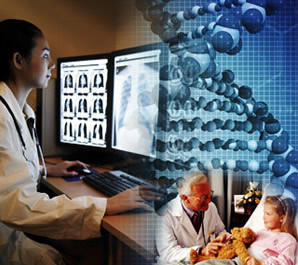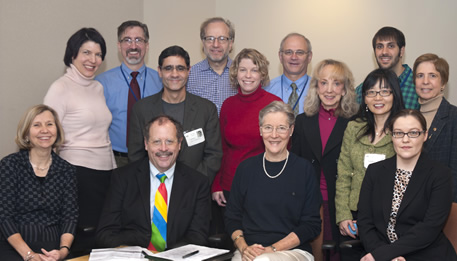Last updated: January 17, 2014
Harvard Medical School To Play Key Coordination Role In Nih Undiagnosed Diseases Network
Harvard Medical School to play key coordination role in NIH Undiagnosed Diseases Network
By Raymond MacDougall
Associate Director of Communications, Division of Intramural Research

The National Institutes of Health (NIH) Common Fund took a major step toward shaping its multi-site Undiagnosed Diseases Network (UDN) with the selection of Harvard Medical School as the UDN Coordinating Center. The $9 million, four-year award begins the expansion of the NIH Undiagnosed Diseases Program to which doctors across the country have turned for help in diagnosing their patients' puzzling conditions.
"The Undiagnosed Diseases Network Coordinating Center at Harvard Medical School will serve as a resource to assist in supporting and managing the UDN," said Anastasia Wise, Ph.D., UDN program director at the National Human Genome Research Institute (NHGRI), part of NIH. "Our colleagues at Harvard will play the important role of facilitating collaboration among laboratory and clinical researchers across multiple clinical sites and in sharing data and approaches generated from cases as widely as possible throughout the scientific community."
The Harvard group will help translate the successful NIH Undiagnosed Diseases Program into preliminary protocols and operating guidelines that will begin to define the framework for the expanding network. In summer 2014, NIH expects to announce the selection of five to seven UDN clinical sites around the United States that will form the network. The network will develop common protocols and collaborate across sites to advance the clinical approach to undiagnosed diseases.
"We will be shaping an initial framework of common practice that can be shared across the network," said Isaac Kohane, M.D., Ph.D., and Lawrence J. Henderson Professor of Pediatrics at Harvard and principal investigator for the coordinating center. "We will establish common protocols for data collection and approaches to patient selection, evaluation and diagnoses, while leaving room for innovation."
Undiagnosed diseases are disorders with long-standing symptoms that have not been diagnosed despite extensive clinical investigation. They include diseases that are not recognized because they are so infrequent, some that have never been described and rare varieties of more common diseases.
 |
To diagnose these conditions, doctors in the network will engage bench researchers in investigating disease mechanisms and potentially developing treatments using genomic data. The UDN program will also train clinicians in the use of contemporary genomic approaches that are proving increasingly effective in making diagnoses.
The original Undiagnosed Diseases Program will continue to operate at NIH. Since that program's 2008 launch, NIH doctors have seen more than 600 patients with unknown conditions, about half of them children. They have achieved a 25 percent success rate in achieving a diagnosis, with some diagnoses taking as little as a week and others taking as long as two years. A number of new conditions have been diagnosed through the program, which is run by NHGRI, the NIH Clinical Center and the NIH Office Rare Diseases Research.
"The added capacity of the Undiagnosed Diseases Network will help us immensely in our work," said William Gahl, M.D., Ph.D., NHGRI clinical director and founding director of the NIH Undiagnosed Diseases Program. "We are thrilled that we will soon have a network to engage in this work with us. We are learning a great amount from studying difficult-to-diagnose disorders."
The NIH Common Fund, which announced the creation of the UDN in 2012, supports cross-cutting programs that are expected to have exceptionally high impact. All Common Fund initiatives invite investigators to develop bold, innovative and often risky approaches to address problems that may seem intractable or to seize new opportunities that offer the potential for rapid progress.
"Establishing the UDN Coordinating Center is an important first step to getting the new UDN up and running," said James Anderson, M.D., Ph.D., director of the Division of Program Coordination, Planning, and Strategic Initiatives, which oversees the NIH Common Fund, including the UDN. "We are excited to build on the success of the NIH Undiagnosed Diseases Program, and to expand our efforts to bring diagnoses and hope to patients suffering from rare or even previously unknown diseases."
For more about the NIH Undiagnosed Diseases Network, visit http://commonfund.nih.gov/Diseases/ or http://www.genome.gov/27550959/undiagnosed-diseases-network-udn/.
Last Updated: January 17, 2014